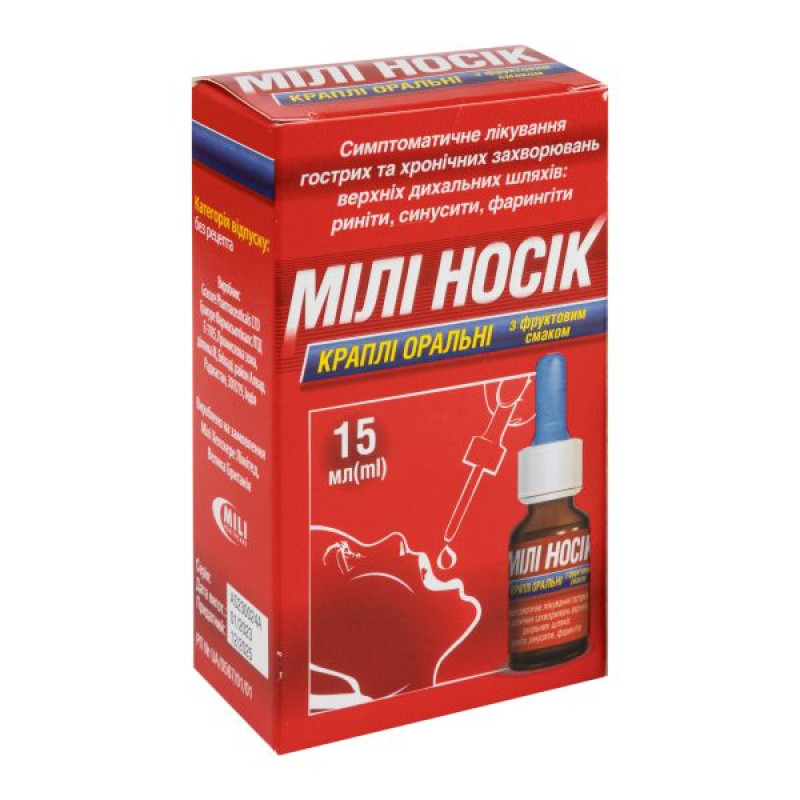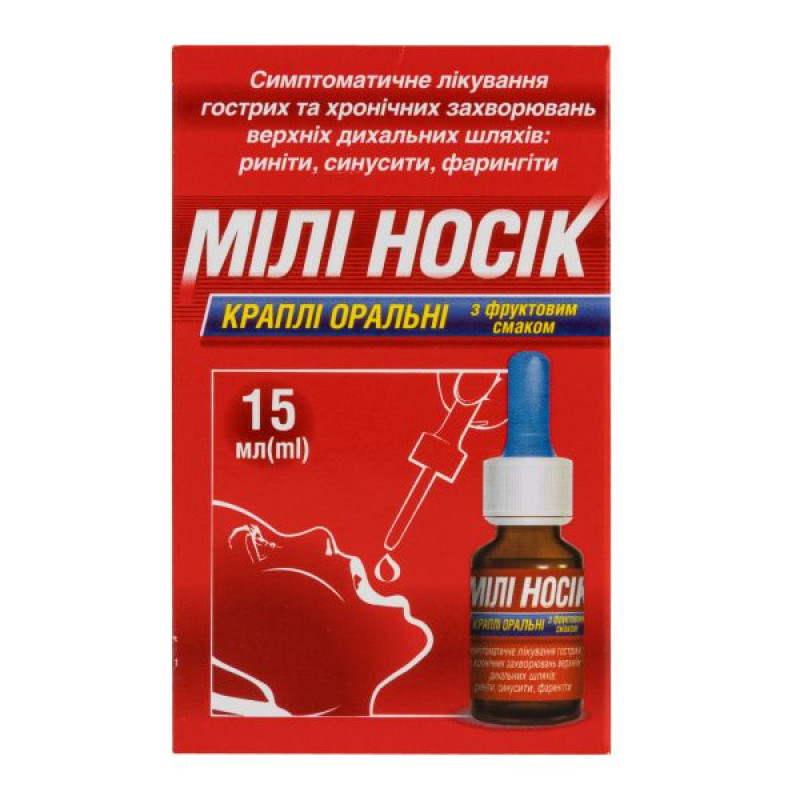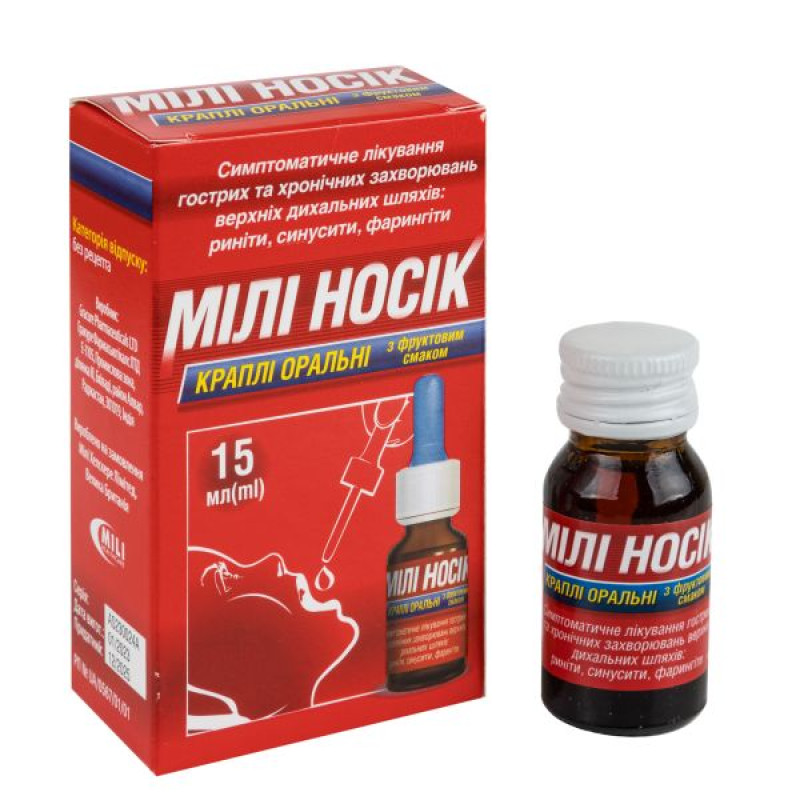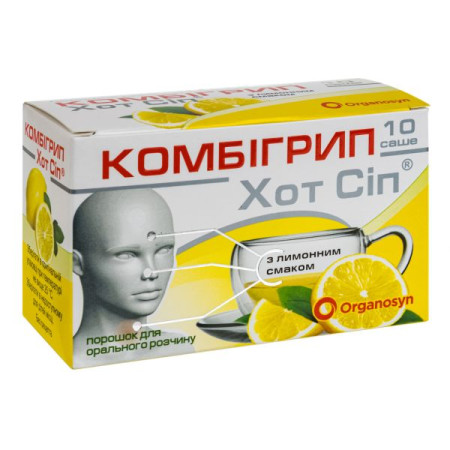Mili Nosik drops for oral use bottle with fruit flavor 15 ml

Instructions for use Milli Nosik drops for oral use, fruit-flavored bottle, 15 ml
Composition
active ingredients: chlorpheniramine maleate, phenylephrine hydrochloride;
1 ml contains 2 mg of chlorpheniramine maleate, 2.5 mg of phenylephrine hydrochloride;
excipients: sucrose, benzoic acid (E 210), disodium edetate, sorbitol solution (E 420), propylene glycol, sodium hydroxide, raspberry flavoring, carmoisine dye (E 122), purified water.
Dosage form
Oral drops with a fruit flavor.
Main physicochemical properties: clear liquid from light pink to pink.
Pharmacotherapeutic group
Anti-edematous agents for systemic use in nasal cavity pathology. ATX code R01 BA53.
Pharmacological properties
Pharmacodynamics
Phenylephrine is a sympathomimetic aminophylline that causes vasoconstriction by stimulating α-adrenergic receptors located on the postcapillary vessels and cavernous-venous sinuses of the nasal mucosa. Vasoconstriction reduces blood supply to the nasopharyngeal mucosa and thus causes a long-term reduction in its edema.
Chlorpheniramine maleate is a blocker of H1-histamine receptors. It has an antiallergic effect, reduces the manifestations of exudation. It has a moderately pronounced sedative effect.
Pharmacokinetics
Phenylephrine is rapidly absorbed from the gastrointestinal tract. It is distributed to various tissues and fluids, metabolized by MAO in the intestinal wall and in the liver. It is excreted unchanged in the urine.
Chlorpheniramine maleate is well absorbed from the gastrointestinal tract. Its highest plasma concentration is reached 1-4 hours after oral administration. It crosses the placenta and is excreted in breast milk. It binds well to plasma proteins, is completely metabolized in the body and is excreted mainly in the urine as metabolites.
Indication
A cold accompanied by rhinorrhea, a feeling of nasal congestion, tearing, and constant sneezing.
Infectious and allergic rhinopharyngitis, pollinosis (hay fever); symptomatic treatment of acute and chronic diseases of the upper respiratory tract: rhinitis, sinusitis, pharyngitis.
Contraindication
Increased individual sensitivity to the components of the drug or to other antihistamines; severe cardiac conduction disorders, decompensated heart failure; arterial hypertension, severe atherosclerosis, severe coronary artery disease; epilepsy, pheochromocytoma, hyperthyroidism, angle-closure glaucoma, urethral and prostate diseases with difficulty urinating, bladder neck obstruction; pyloroduodenal obstruction, renal failure, diabetes mellitus.
Do not use with monoamine oxidase inhibitors (MAOIs) and within 2 weeks after discontinuation of MAOIs, with concomitant use with tricyclic antidepressants or ß-blockers.
Interaction with other medicinal products and other types of interactions
Phenylephrine.
Phenylephrine hydrochloride should not be used with α-blockers, other antihypertensive agents, phenothiazine derivatives (e.g. promethazine), bronchodilator sympathomimetic agents, guanethidine, digitalis, rauwolfia alkaloids, indomethacin, methyldopa, glucocorticosteroids; drugs that affect appetite, amphetamine-like psychostimulants, labor stimulants, anesthetics, ergot alkaloids, other drugs that stimulate the central nervous system, theophylline.
It is possible to increase the vasoconstrictor effect of the drug when used simultaneously with stimulants of labor activity and arrhythmias when used with anesthetics. It is possible to significantly increase blood pressure with simultaneous intravenous administration of ergot alkaloids.
Atropine sulfate blocks the reflex bradycardia caused by phenylephrine and increases the vasopressor response to phenylephrine. Concomitant administration of phenylephrine with ß-blockers may lead to arterial hypertension and excessive bradycardia with possible heart block. It should be used with caution with thyroid hormones, drugs that affect cardiac conduction (cardiac glycosides, antiarrhythmic drugs). When used simultaneously with drugs that cause potassium excretion, for example, with some diuretics such as furosemide, hypokalemia and decreased arterial sensitivity to vasopressor drugs such as phenylephrine may be increased.
Should not be used together with other vasoconstrictors (by any route of administration).
Concomitant administration of phenylephrine and other sympathomimetics may result in excessive central nervous system stimulation, with nervousness, irritability, and insomnia. Convulsions may also occur. In addition, concomitant administration of other sympathomimetics with phenylephrine may potentiate the vasoconstrictor or cardiovascular effects of either drug.
Enhances the effect of drugs that depress the central nervous system (hypnotics, anesthetics, MAO inhibitors, tricyclic antidepressants, antiparkinsonian drugs, barbiturates, tranquilizers, narcotic analgesics, and alcohol), enhances the anticholinergic effect of atropine, antispasmodics, and antiparkinsonian drugs.
May inhibit the action of anticoagulants and interact with progesterone, reserpine, thiazide diuretics. Simultaneous use of contraceptives may lead to a decrease in the effectiveness of the antihistamine component of the drug.
Application features
The drug should be prescribed by a doctor only after assessing the risk/benefit ratio in the following cases: arterial hypertension, ischemic heart disease, Raynaud's disease/syndrome, urination disorders, increased intraocular pressure, prostatic hypertrophy, pancreatitis.
Aminophyllines can cause central nervous system dysfunction and, as a result, cause convulsions. Phenylephrine, which is a component of the drug, can have a vasoconstrictor effect, cause cardiovascular failure with manifestations of arterial hypotension. In this regard, the drug should be used with caution in patients over 70 years of age and patients with cardiovascular diseases.
During treatment with the drug, sedative/hypnotic drugs (especially barbiturates) that enhance the sedative effect of antihistamines (chlorpheniramine maleate) should not be used. Use with caution in patients with liver and kidney diseases.
If the disease is caused by a bacterial infection, simultaneous treatment with antibiotics is recommended.
It is forbidden to drink alcohol while taking the drug!
Do not use in patients with hereditary fructose intolerance, glucose-galactose malabsorption or sucrose-isomaltose malabsorption.
Use during pregnancy or breastfeeding
Not recommended for use during pregnancy and breastfeeding.
Ability to influence reaction speed when driving vehicles or other mechanisms
While using the drug, the patient should avoid driving, operating machinery, and other potentially dangerous activities.
Method of administration and doses
A graduated pipette is inside the package.
Children aged 4 to 6 years: 1.0 ml;
Children aged 6 to 12 years: 1.5 ml;
For children over 12 years of age and adults: the dose is set individually - 1.5-2 ml.
Take orally 3 times a day. Maximum duration of treatment: 4-5 days.
Children
Do not use in children under 4 years of age.
Overdose
Symptoms of phenylephrine overdose: in case of overdose, the manifestations of adverse reactions may be increased, especially with prolonged use.
Cardiac arrhythmias, increased blood pressure, hypotension, pain and discomfort in the heart area, palpitations, shortness of breath, non-cardiogenic pulmonary edema, agitation, convulsions, headache, tremor, sleep disturbances, anxiety, nervousness, irritability, inappropriate behavior, psychosis with hallucinations, insomnia, weakness, anorexia, nausea, vomiting, oliguria, urinary retention, painful or difficult urination, facial flushing, feeling of coldness in the extremities, paresthesia, pale skin, piloerection, increased sweating, hyperglycemia, hypokalemia, peripheral vascular narrowing, decreased blood flow to vital organs, which can lead to deterioration of renal blood supply, metabolic acidosis, increased workload on the heart due to increased total peripheral vascular resistance. Severe effects of vasoconstriction may occur more frequently in patients with hypovolemia and severe bradycardia.
In case of an overdose of chlorpheniramine maleate, atropine-like symptoms may be observed: mydriasis, photophobia, dry skin and mucous membranes, increased body temperature, tachycardia, intestinal atony. Usually, symptoms of central nervous system excitation are first observed (psychomotor agitation, impaired motor coordination, hyperreflexia, convulsions), and then depression, drowsiness, impaired consciousness, which are accompanied by respiratory disorders and impaired functioning of the cardiovascular system (heart rhythm disturbances, extrasystole, decreased pulse rate, decreased blood pressure up to vascular insufficiency).
Treatment is symptomatic.
Adverse reactions
Cardiovascular system: heart rhythm disturbances, tachycardia, reflex bradycardia, increased blood pressure (especially in patients with arterial hypertension), feeling of blood rush to the face.
Gastrointestinal: nausea, vomiting, diarrhea, dyspepsia, flatulence, dry mouth, anorexia.
From the genitourinary system: urinary retention, difficulty urinating.
Nervous system: headache, dizziness, feeling of fear, sleep disturbances, insomnia, drowsiness, feeling of anxiety, agitation, tremor, hallucinations, convulsions, epileptic seizures, dyskinesia, coma, behavioral changes.
Skin and subcutaneous tissue disorders: skin rash, itching, pallor of the skin, exfoliative dermatitis.
On the part of the organs of vision: dryness of the mucous membrane of the eyes, decreased visual acuity, mydriasis, increased intraocular pressure.
From the blood and lymphatic system: hemolytic anemia, fluctuations in blood glucose levels.
Immune system disorders: hypersensitivity reactions, including angioedema, anaphylactic reactions.
Others: dry nose, weakness.
Expiration date
2 years.
Storage conditions
Store at a temperature not exceeding 25 0C, in the original packaging and out of the reach of children.
Packaging
In dark glass or plastic bottles of 15 ml with a graduated pipette in a cardboard box.
Vacation category
Without a prescription.
Producer
Gracure Pharmaceuticals LTD.
Location of the manufacturer and its business address
E-1105, Industrial Area, Phase III, Bhiwadi, Rajasthan, Alwar District, 301019, India.
Applicant
Mili Healthcare Limited, Great Britain
Applicant's location
Fairfax House 15, Fulwood Place, London, WC1V 6AY, Great Britain.
There are no reviews for this product.
There are no reviews for this product, be the first to leave your review.
No questions about this product, be the first and ask your question.











